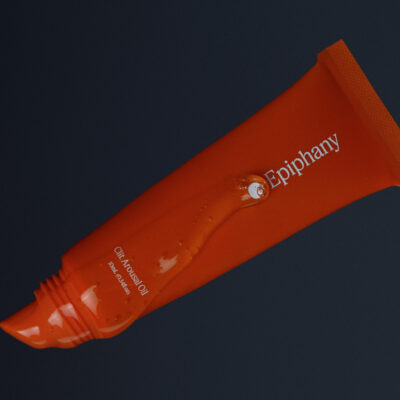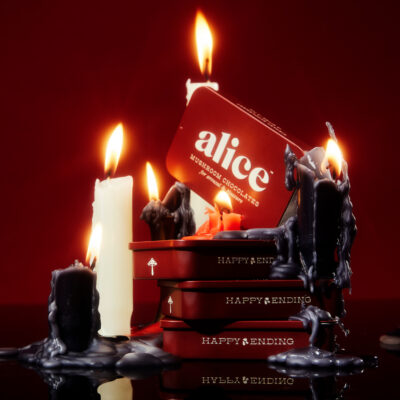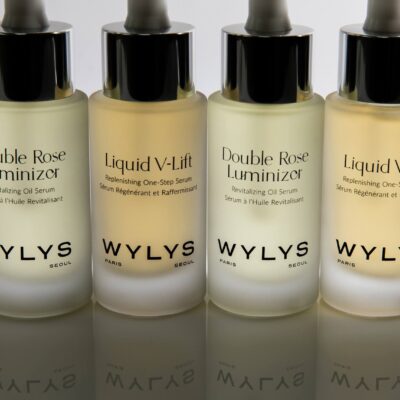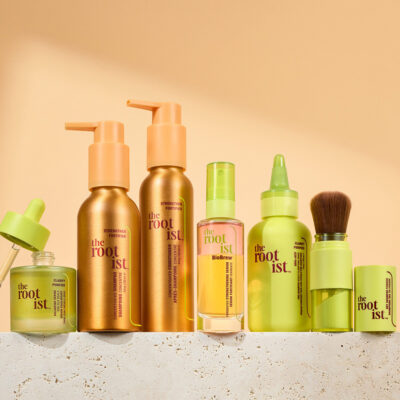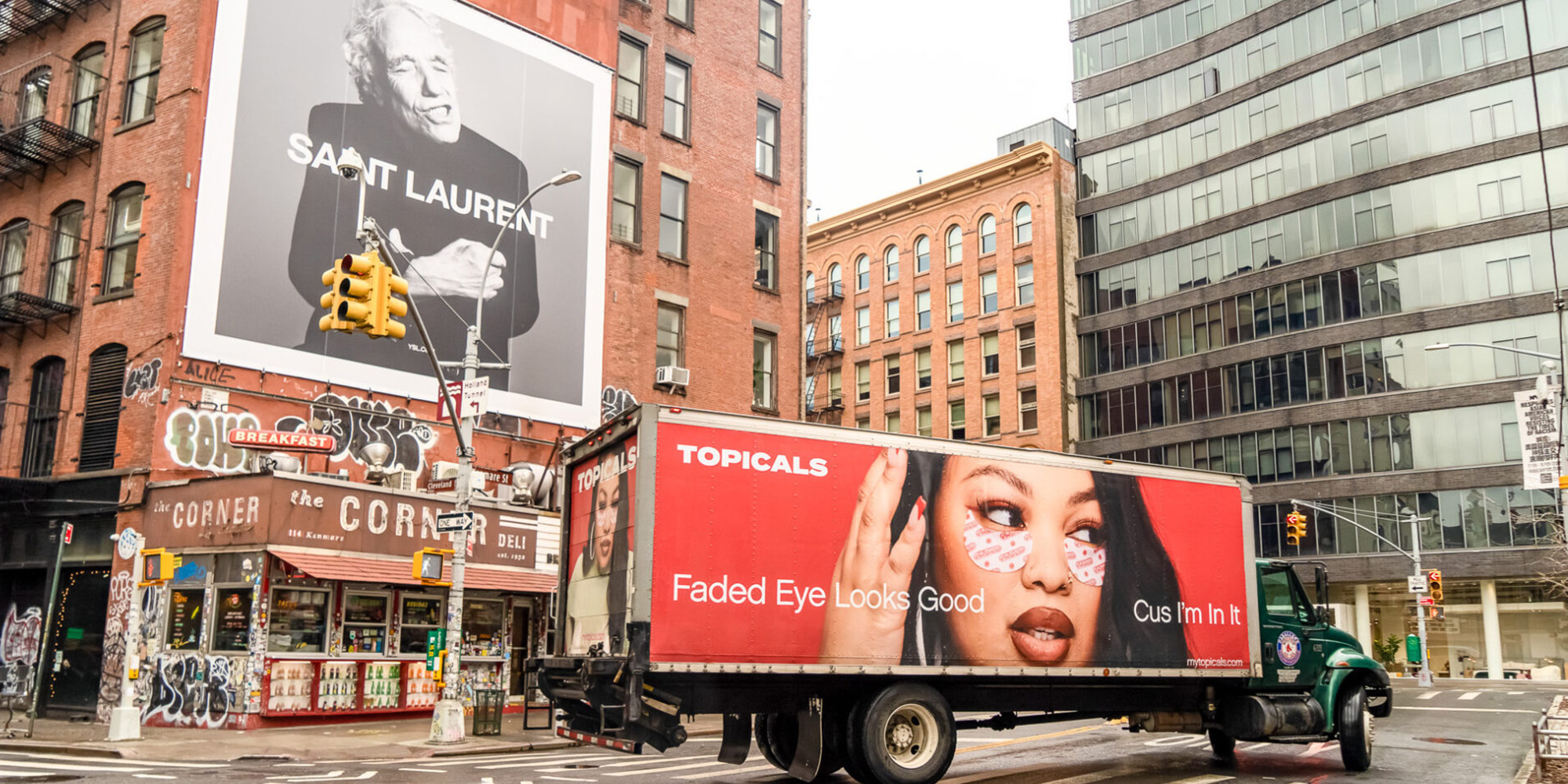
Talking Trucks With Tom Shea Of Adgile, Emerging Beauty Brands’ Go-To OOH Advertising Company
In 2023, omnichannel has become critically important across the spectrum of brand building, whether it’s distribution, supply chain, marketing and more. Adgile Media Group, which calls itself “your favorite CPG brand’s favorite OOH brand,” is a beneficiary of brands increasing the channel plays in their omnichannel marketing playbooks.
“They’re struggling with marketing post-iOS 14.5, which made paid social a bit more complicated, and some people are hitting an upper bound where, ‘I can’t spend more than $10,000 otherwise the performance degrades miserably,’” says Tom Shea, co-founder of the company specializing in advertising on the sides of trucks. “They’re looking for the next efficient frontier of marketing.”
Adgile’s website offers an estimate that truck advertising is “4X more effective than standard billboard advertising and provides a 300% increase in digital ad ROI.” Trucks are essentially moving billboards, but Shea points out advertisements on them are cheaper than billboard ads, and they’re super shareable.
“People aren’t itching to share their Amazon or their Facebook marketing campaign, but, generally, when they do out of home, a big part of the value is the potential earned intermedia online,” he says. “We’re obviously fortunate that that’s embedded in the product.”
When Adgile launched in 2020, skincare brand Topicals was one of its first beauty clients. Its beauty client roster has since ballooned to include Starface, Saie, Cadence, Vacation, Glossier and Tower 28. Today, beauty brands make up a quarter of Adgile’s revenues.
Ahead, we speak with Shea about the early days of Adgile, getting on the radar of beauty brands, a few of those brands’ coolest campaigns, the price of truck ads and the ROI expected from them.
How did Adgile get started?
I studied computer science, finance and chinese at Boston College. I took a corporate America-type job in Los Angeles at a company called McMaster-Carr Supply Co. to automate things. Eventually, they asked me to move to Chicago, where that company was headquartered, to join the software team. As soon as I moved to Chicago, I met my business partner, Max Flannery, who had Adgile 1.0 as a business idea that he wanted to start. At the same time, I was also enrolling at the University of Chicago for nights and weekends for an MBA.
The first idea was digital screens on trucks, and there wasn’t any of the attribution. We were like, it would be really interesting to have time, location and contextually aware advertisements on trucks. We were looking around at every other commercial type of transportation: buses, subways, taxi tops, and all of them had been offset by advertising subsidies, except for delivery vehicles. So, we were like, let’s put digital screens on trucks, and I would write the software to make the ads time, location and contextually aware.
What would that have looked like? Say a truck’s going down I-95, and it’s passing exit 4, 5, 6. For the three miles leading up to exit 4, if there’s a McDonald’s, something on that advertising screen would say, “McDonald’s coming up, getting hungry? Turn off at exit 4.” Then, as soon as it would pass exit 4, you’d switch to whatever it was off exit 5. “Gas station coming up, running low on fuel? Look at your gas tank. If you need gas, turn off here.” We had this grand vision of really making it pretty advanced.
We ran into two issues when we spoke to investors. The first was the capex of the screens was really expensive. People were like, “Hey, this is pretty cool, but you’re going to need like $20 million because this is essentially a hardware startup.” And no one’s going to put up that money just for you to run an experiment. The bigger issue we had was we were using long-haul trucks, so think trucks that are 53 footers that go from Chicago to Savannah, Georgia and back each day. We didn’t have a marketing background, so we didn’t know meaty dollars get allocated at the national, regional and local level.
If you think of a McDonald’s-type company, they’re only investing in something that can touch the entire country. Because we only had this one route, you couldn’t compete for national budget. We couldn’t compete for regional because our assets were only traversing through those landscapes once or twice per week. That means you’re left with local and that entails selling into every single individual franchise owner like the mom-and-pops that own one McDonald’s. This would become a really tricky business to scale when you have to talk to that many people.
We went from 53-foot trucks that traverse county and state lines to last-mile delivery trucks, which is this truck that’s going to stay in New York City only, Chicago only, LA County only. That way we can keep at least regional and local dollars, and then eventually national dollars when we got big enough. The other element was, how can we find something that’s less cost intensive to scale? We went from digital screens on trucks to static wraps, which is the current iteration of the business.
The proble people really wanted us to solve for was, what’s the return on investment of these types of executions? While we simplified the product on the front end or what’s exposed to consumers, we leaned really hard on the technical side and built a technology measurement attribution platform to be able to understand the return on investment. Adding that to our suite of services, that’s when we started to find product-market fit. People could very clearly see, here’s what I invested, here’s what I got in return, how did that compare to direct mail, TV, Facebook, TikTok? That’s the business model we brought to market in 2020. We raised venture capital thereafter and now work with well over 150 consumer brands.

How did you get on the radar of beauty brands?
It was more dumb luck than a clear methodical strategy. My sister [Katie Shea, co-founder and managing partner at Divergent Capital] is a consumer investor, and she’s invested in Topicals. When we were starting Adgile, we knew in order for people to take us seriously, we needed to essentially burn money for the sake of adoption. We went to our network saying we’re going to give these things away, it’s going to be so cheap relative to other forms of out-of-home. A billboard in New York can cost $150,000 per month. We were doing something like $1,000 per truck per month and taking significant losses on that, but we did so for the sake of collecting data.
The two clients that we’ll always be indebted to are Olamide [Olowe] at Topicals and Mélanie [Masarin] at Ghia. They took a chance on us. We did an activation on their behalf, and they continued to renew. We kept increasing the price, and they kept coming back. We’re like, “Wow, Olamide, why do you keep coming back to work with us and keep using these trucks for Topicals?” We thought it was the price point. We thought it was the technology. You can see the return on investment very clearly. But what we heard in return was not what we expected. It was, “We like this form of advertising because it’s the only form of advertising where no one knows it’s an advertisement.”
We double clicked on that, and we did a long-form behavioral psychology study to coin what we call the “virtual fleet effect” of Adgile. The virtual fleet effect is essentially that 96.3% of people who see a branded truck believe it is delivering on behalf of the advertised brand. If Topicals is on a billboard, everyone knows they paid for an ad. If they do wheat pasting, everyone knows it’s an ad, but when they wrap 10 trucks, everyone’s saying, “Holy shit, Topicals is on fire.” The presence of this distribution network they have suggests that all of my neighbors are buying that product. The trucks break that illusion of scale, making it look like everyone’s buying that product.
In terms of beauty adoption, the other thing is Mélanie from Ghia, she was high up at Glossier. Her peers went to go found other companies, and a lot of them ended up staying in that category. Fast forward, that’s where we were strongest. A lot of these people are looking at emerging brands that are on fire, trying to study their playbook and going, “That company’s taking market share from us, what are they doing that we’re not doing?” That created this critical mass of adoption in the beauty category that started with Topicals and has gone up to Glossier.
It’s interesting that customers don’t realize brands advertise on trucks and assume they’re transporting the goods of the brand on the side of the trucks. Are trucks going the route they’re on anyway? Is that how it works?
This gets a little into the investment world of why people actually back the company, but 50% of all last-mile delivery trucks are leased, which means there’s a handful of companies that control half of the trucks in the market, and these are your Penskes, Ryders, NationaLeases. You and I know them as consumers as rental truck companies, but the much bigger part of their business is leasing trucks out to companies.
We went to the leasing companies and said, “We’ll pay the trucking operator for the rights to advertise. In exchange, please reveal the GPS information for all of the assets that you have leased out.” That allowed us to take that information and go, what is the top 10% of assets from a performance and quality perspective?
Most trucks are bad for advertising. They’re in loading docks all day out of view. They’re only on the road for a day or they’re only on the road during night times when there’s not as much city congestion. By getting the access to that information, we’re able to say, what are the top assets in every single market across the country? Then, we moved to lock those up on an exclusive basis.
You’re correct, these are assets that are already on the road. That was an important part of our business from a sustainability perspective. We didn’t want to add a carbon footprint for the sake of advertising. We simply found something that existed and are extracting greater utility out of it, but having such a deep supply side allows us to get very specific and granular based on the business objectives of a client.
For example, if we have a DTC-only beauty brand, we’re probably optimizing for performance and persona. So, most views per truck, per day, per dollar and the right type of views, certain income, race, ethnicity, things like that. If you get a brand that’s saying, “Hey, we’re launching in Sephora. We’re trying to drive more sales in Sephora,” we’ll be putting forth an asset that’s spending the majority of its media exposure near the point of purchase, usually within one mile of that point of purchase.
“If Topicals is on a billboard, everyone knows they paid for an ad, but when they wrap 10 trucks, everyone’s seeing those and saying, ‘Holy shit, Topicals is on fire.'”
Are there certain cities or areas that you’re limited to?
We support the top 50 cities nationwide. We have about 35 campaigns in about 35 markets at this time. Back to our performance growth marketing roots for emerging brands, I’m generally not letting them activate anywhere outside the top 10 markets [New York, Los Angeles, Chicago, Philadelphia, Dallas, San Francisco, Washington, D.C., Houston, Boston and Atlanta] because that’s where the dollar gets stretched the furthest.
The instances where we’re not in a major market there’s typically a business case that overrules the need to provide a high return on investment in the short term. So, what do I mean by that? PepsiCo wants to activate in Cincinnati because they feel like their marketing efforts in the past have reached saturation in a place like New York and LA, and they’re solving for a business case that’s opening up a new market to continue to grow the market share that they have.
Sometimes people are like, “Hey, we’re trying to get into the Hamptons.” Well, there’s only two billboards on the way to the Hamptons, and they’re on a Native American preservation, so it was essentially impossible to get out-of-home in a place like the Hamptons until we went to market. Same thing with Cape Cod. It’s illegal to have billboards in the state of Vermont. We do a lot of work in Austin, Texas because population growth has increased at a rate quicker than the out-of-home infrastructure can support. So there are all of these interesting business cases that have made us an attractive buy despite us still believing that the best markets activator are those major ones with high population density.
In terms of imagery for the truck, is that a collaborative effort? Is there advice that you give brands in terms of what they should put on side of the trucks?
When we started the business, we did not get involved in creative because we’re not creatives by trade. I would still maintain that’s probably not our strongest suit. However, what’s really interesting about being able to measure campaign performance is now we can follow the data to understand what works best and what doesn’t. Before a campaign goes live, we usually ask for an hour directly with whoever’s creating the design brief so that we can take them through what data and experience has taught us about optimizing creative.
I’ll give things that I think are really fascinating. One of them is color psychology. Red works really well. Why does red work really well? What does red communicate? Stoplights, brake lights, stop signs. All of those things communicate in society, stop and pay attention. When you have that on a 30-by-10-foot truck-side advertisement, it has that same emotional visceral response where you want to stop and pay attention.
Purple is another really powerful one because it’s the least naturally occurring color in society. If you think of where you see purple naturally, it’s rainbows, sunsets and flowers. When it shows up on a large format out-of-home, it creates a ton of contrast, and people want to look at it. Orange is another one that crushes, yellow is another one that crushes.
What beauty brand campaigns stand out?
The first Topicals campaign we ever ran was with a white background. It did a lot of things right, to be honest, the logo’s striking, there’s a CTA, there’s a quip, there’s an engaging image. The thing that I didn’t like about it is, what is the average truck in any market? It’s white. As humans, we’ve been socialized to start to ignore things that we see frequently. We’ve done a ton of campaigns with Topicals, and the [latest campaign] used a red background. That’s something that’s really a standout.
What we’ve done a lot more lately is what I’ll call experiential light. I’ll give the beauty brand Saie the credit for this. They came to us and were like, “Hey, can we take a truck for eight hours and use it to do sampling in front of every Sephora in New York City. We’re going to support it with an in-store team that can help educate people on Saie brands when they walk into Sephora. What we’ll do is we will pay the driver a couple hundred bucks for his or her time and for the opportunity cost of that time to shift their delivery schedule around that week and, in exchange, we can deploy these assets.”
We did that, and it created a massive upswell. There were hundreds of people in the street as they were handing out Saie bags full of product. That cost them under a thousand dollars to do, and fans and Sephora buyers were so happy to see this cool unique activation. We’ve replicated that across a number of brands like Crown Affair. There’s a ton of brands that had us deployed to the Taylor Swift concerts this year. Kosas did something epic where they had 10 trucks outside Sephoria this year on the press and influencer night.
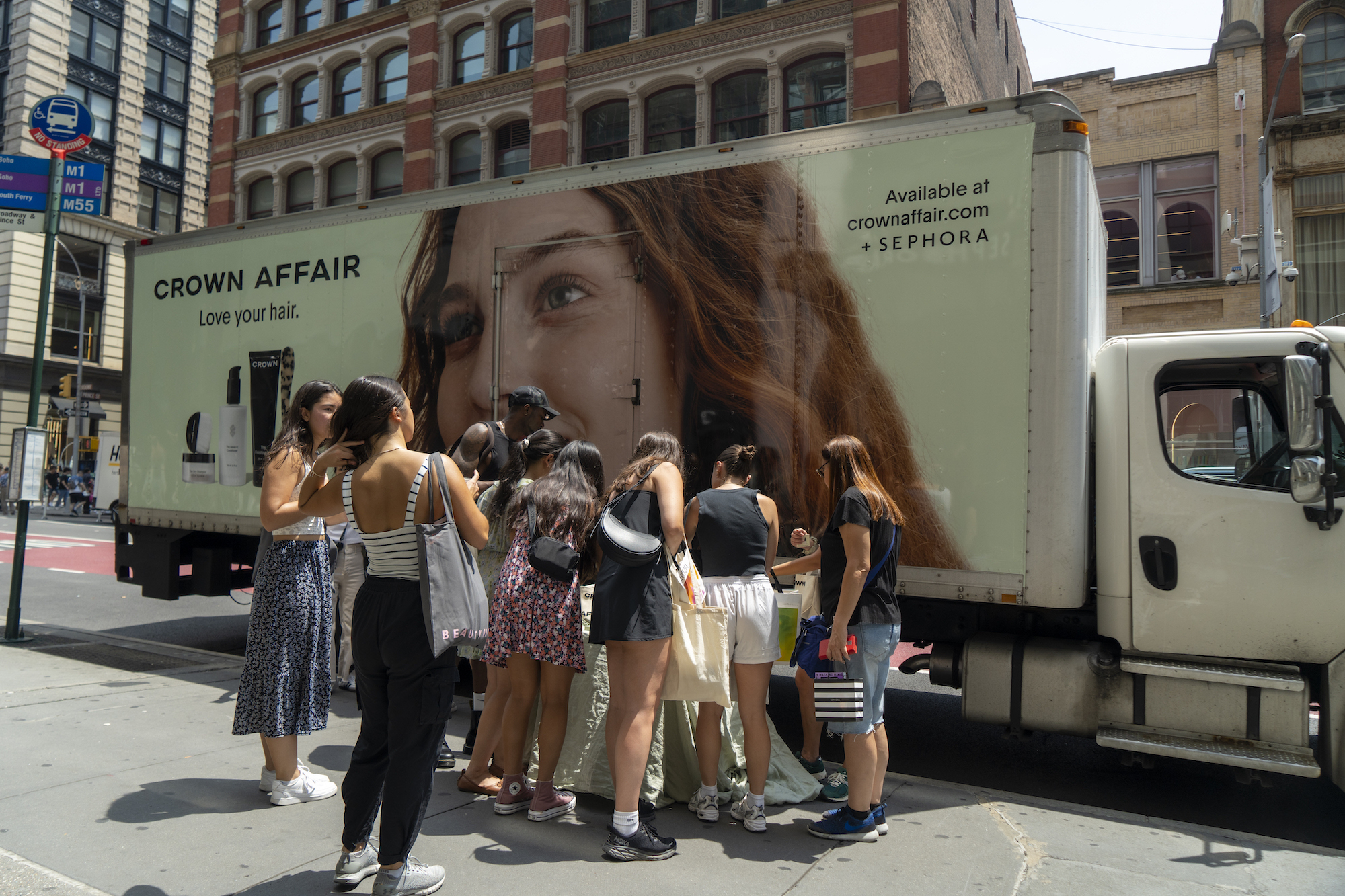
Are there things that can’t be on trucks?
The truck operators get right of first refusal always. So, if it’s a conflict of interest with what they’re delivering, if they’re otherwise not comfortable—sometimes people will put expletives—they always get the right to say, “Hey, I’m not comfortable with this,” which is totally fine.
In terms of best practices, I generally give people the advice to not leverage QR codes on the rear panels if they can. Yes, maybe there’s some incremental performance left on the table. I highly doubt it personally. But when you think about brand adjacency, you don’t want to be the brand that is associated with encouraging distracted driving.
Otherwise, there aren’t really restrictions. We’re a common landing place for sexual wellness and CBD brands that have an issue advertising online. Our campaign with August has well over 10 million TikTok views at this point, and there’s period blood directly on the advertisement. We have been able to support things that would otherwise probably have a hard time being successful.
Can you speak more about your technology that measures ROI?
In every single asset we have under management is a GPS in the vehicle streaming to us via an API latitude, longitude and timestamp. We ingest the information from the GPS’s API, then we geofence around that vehicle every second capturing mobile phones that have location services enabled. When we capture someone’s location data, it kicks off our entire stack. We can do what’s called ID stitching and go from the mobile phone to their desktop, tablet, partners’ devices, etc. We can figure out their age, education, income, race, interests. All of this information allows us to be intelligent about which trucks get into which campaigns because obviously that information varies based on its route.
Most importantly, we can do attribution. I’ll keep in the context of an e-commerce business. Take Topicals.com, we’re putting a pixel on their homepage and their post-checkout page. Those pixels are listening for the same population of mobile phones that were exposed to the branded truck within 14 days of exposure. If someone saw the truck, if they visit Topicals or buy something on Topicals within 14 days, we’re logging that information.
While it is a fun and convenient narrative to try to tell the Topicals team, “Hey, someone saw your truck and then they bought something on your website within 14 days,” that actually tells you almost nothing of interest as a marketer because that’s one touch in a media mix that’s going to have PR, affiliate, word of mouth, paid social, direct mail, CTV, out-of-home. Just because someone saw the truck and bought something, it doesn’t necessarily tell you if the trucks work or not.
The business case for us became, how do you solve for incrementality or the unique amount of conversions you got because this got added into the media mix? Everything I shared with you is our hypothesis group, it’s people who are exposed to the truck that go to the website, but simultaneously we create a control group by taking the truck’s live GPS information going 10 minutes backwards on its GPS route and dropping a pin using software called our ghost truck. Then, we geofence around the ghost truck every second.
You can picture there’s a real truck and then there’s a fake truck, which is just a piece of software. They’re on a 10-minute lag from each other and both are being geofenced every second. In doing so, we’re creating a clean testing environment where, between those two populations, all other variables have been held constant. There’s an equal likelihood that they have seen paid social, PR word of mouth, even other forms of out-of-home. The only difference is one group has seen trucks, one has not, and we measure and report out on the discreet conversion behavior difference between those two populations.
Hypothetically speaking, let’s say we log 10,000 conversions around the branded truck population and we log 9,000 conversions around the ghost truck population, then what we’re reporting back is Adgile drove these a thousand incremental conversions and, based on your average order value, that results in a return on investment of Y, for example.
How does the ROI for a truck campaign compare to a digital campaign?
Obviously it depends, but the average return on ad spend across the 200-ish or so brands we’ve worked with thus far assuming a 14-day moving conversion window is a 2.94 return on ad spend. Said differently, for every $1 invested in Adgile, we’ve been able to generate, on average, $2.94 for the brand.
Can you share how much a truck ad can cost?
I’ll tell you two variables that I think paint broad strokes without me divulging something that could change. I’d say the average test-and-learn campaign, where it’s making impact and we can learn something from it, is about $30,000. That includes multiple trucks for multiple months. Our average contract value today is about $72,000.
A a lot of people look at stuff with an 80/20 rule, 80% of the time we invest in things we know, 20% we experiment with budget to see if there’s something really great here that we can then move into the core 80%. Most people are testing and learning this with about a $30,000 budget and, assuming success, are continuing to scale into it.
Does the price differ depending on the location?
It does not, which goes back to why I encourage brands to stay in those top 10 markets. The dollar goes much further there.
What’s the criteria you look for in a brand?
If you are an e-comm-first brand, I’m generally looking for 5,000 daily website visitors or greater. If you are a retail-first brand, it varies depending on the category. If it’s food and beverage, I want at least 50 points of distribution. If it’s beauty, you probably want to be launching in one of the big ones, Sephora, Ulta or Credo, something like that.
This interview has been edited for brevity and clarity.

